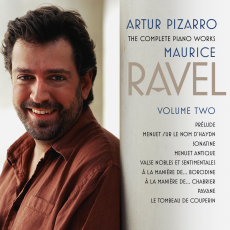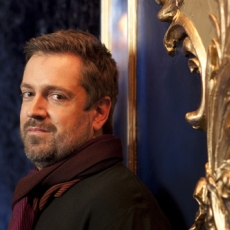Maurice Ravel Volume Two - Artur Pizarro - StereoMojo
Artur Pizarro's second volume of Ravel piano music is made up of a variety of short pieces, both in individual and suite forms. Ravel's fascinating depths of imagination are plumbed deeply on this CD if not always fully revealed as even the artist might wish. Pizarro is a talented pianist with a worldly background having been born and raised in Portugal and ending his formal education attending college in Kansas. He chose that rather remote locale in order to remain a pupil of Sequeira Costa, the same teacher he had worked with in his early years in Portugal. Pizarro seems to be most famous in Great Britain and has released several recordings on a variety of British labels.
I've been living with this album for a while because my first impression was not as positive as I expected. That had more to do with the acoustic and less with Pizarro. Still, he seems to have approved of this sound. Trying to be fair, I listened on several different systems and came away accepting the fact that the venue, a reverberant church, may not be the ideal setting for Ravel's intricate compositions. Ravel takes into account color of tone and use of pedal for effect on the piano in the same way that Berlioz made changes within the orchestra of his day. This CD finally became more interesting as I separated ambiance from music; I found some gems in these performances. Still, I never reconciled with the overall sonic nature of the project. There is a basic lack of focus on the instrument as opposed to the room. Simply put, the outlines of the music are there, but I would like a more substantial core to the piano sound, not the walls, floor and ceiling that surround it.
The CD opens with two very short pieces and by track 3 we have the charming three movement, "Sonatine". The opening is full of promise. The rhythm and balance of harmonies along with the evenness and clarity of touch show that Pizarro has a strong affinity for Ravel's music. Throughout much of the CD my only complaint regarding timbre is the piano's piercing upper register when pushed too hard. This even gave my I-pod a moment or two of grief. The third movement, track 5, suffers most from this problem. Further a warmer piano sound can't be achieved with the current lack of bass. (I'm afraid I don't have any tone controls.) There's little evident below 80 - 100 Hz although Ravel clearly requires it.
In "Menuet Antique" (track 6) these problems remain. When the instrument is played with loud gusto, the sound can become less than pleasing. Though an obvious sense of structure it accessible, sometimes it can sounds indistinct because so much of Ravel's writing is smeared by the acoustic.
"Waltz Noble e Sentimental" (track 7 - 14) is not immediately played to my taste because the tone of the opening is once again too harsh. This is hardly the first time a pianist who specializes in French music has taken this approach. Some French pianists (not all) seem to favor a bright yet brittle sound. Once things calm down a bit the sound has a better sense of proportion. Soon Pizarro allows us to focus on those mysterious moments that that only Ravel and Debussy achieve using the overtone series of the piano. By the end of the piece in track 14, Mr. Pizarro slows enough to let the tone die away and we finally have a true "ppp". If only the beginning were as lovely as the end, this performance would rival any other.
"Dans le maniere de Chabrier" (track 16) is actually full of little hints of the arietta of the character Siebel in the third act of Gounod's opera, "Faust". It has a Chopinesque feeling under Pizarro's fingers. The gentle tugging at the tempo is certainly not the same as Gounod's original, but rather sounds like a Mazurka from time to time. Pizarro has his sights set perfectly here and achieves the right touch and pace. This is a very clever bit of pianism.
"Pavane pour une infante defunte" is splendid. The quasi - loud passages sound far less aggressive and the line is sustained by someone who deeply loves this music. So often this little piece seems to be a dull choice to fill out a student recital. Musically "Pavane" is as far from a chestnut as one can get and Pizarro proves that easily.
"Tombeau de Couprin", full of odd dangers, closes the recording. Its first track, "Prelude" has the rhythmic incisiveness that it requires. The voicing leads to a quicksilver tone, even in the highest register. The scampering notes are beautifully paced. My favorite movement is the third, "Forlane". Again the silvery tone is with us and Pizarro pursues a slightly slower tempo than most. If you know this piece only as an orchestral arrangement, you'll see what I mean. In the piano version Pizarro is able to give the leading voices a wide variety of color. "Rigaudon" follows with a boisterous sensibility; finally there is some idea of Pizarro not being hampered by the acoustic. His attacks are short and secco, but never "slapped". The final "Toccata" closes this CD with panache. The repeated notes are evenly balanced; Ravel makes this piece fiendish for all but the very best pianists. Rapid fire repeats of the same note are nothing new to Ravel. He tortures his enthusiasts with the same writing in both "Gaspard de la Nuit" and ‘Alborada del Grazioso"." I'd like to hear Pizarro play those pieces too. He certainly has the talent to make them work.
My only bit of advice is to listen for the first time on your best headphones. You'll hear the music far more easily than in a listening environment that emphasizes the church's unneeded addition to Pizarro's firm sound.
I hope its obvious that although it took me a bit of time, I came to enjoy this recording thoroughly.
Publisher's note - As usual, André nailed the essence of this performance perfectly. He specified a rating of 3 out of 5 for sound quality and with that I have to take a little issue. Mr. Gauthier listened only to the CD layer without the benefit of its HDCD encoding. There is also a stereo SACD layer as well as full 5.1 SACD surround. I believe the church ambience which absolutely is as described by Andre, fares much better with the full HDCD replay and more in SACD with its higher resolution and even better in surround for which this recording was apparently optimized. As such, while the CD layer sans HDCD is indeed about a 3 on the Mojo Meter, the other variations deserve more. In addition, Linn provides the most comprehensive versions of downloads from compressed mp3 to uncompressed FLAC, full CD and even much higher rez "master track quality" on their website. We applaud Linn's efforts to bring us not only quality performances but releases with the most choices of any label on the planet.

